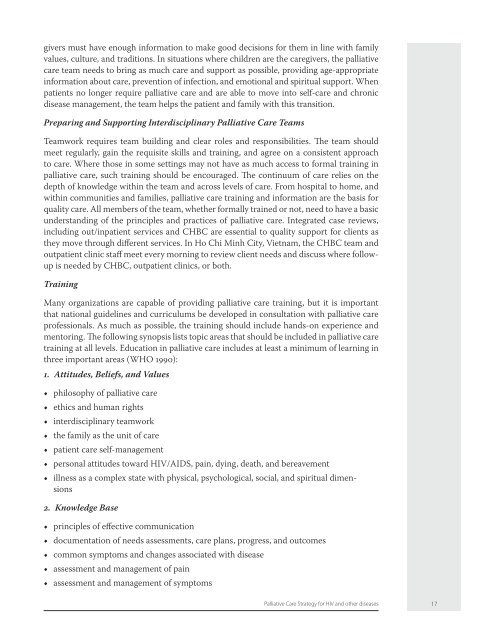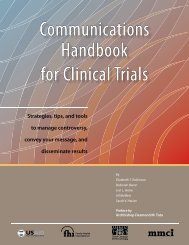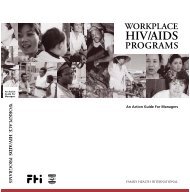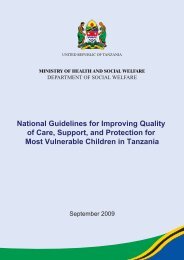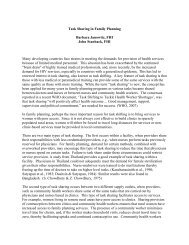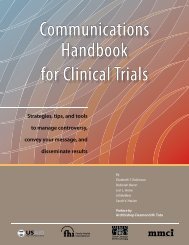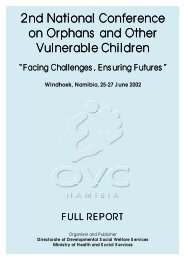Palliative Care Strategy for HIV and other diseases - FHI 360
Palliative Care Strategy for HIV and other diseases - FHI 360
Palliative Care Strategy for HIV and other diseases - FHI 360
Create successful ePaper yourself
Turn your PDF publications into a flip-book with our unique Google optimized e-Paper software.
givers must have enough in<strong>for</strong>mation to make good decisions <strong>for</strong> them in line with family<br />
values, culture, <strong>and</strong> traditions. In situations where children are the caregivers, the palliative<br />
care team needs to bring as much care <strong>and</strong> support as possible, providing age-appropriate<br />
in<strong>for</strong>mation about care, prevention of infection, <strong>and</strong> emotional <strong>and</strong> spiritual support. When<br />
patients no longer require palliative care <strong>and</strong> are able to move into self-care <strong>and</strong> chronic<br />
disease management, the team helps the patient <strong>and</strong> family with this transition.<br />
Preparing <strong>and</strong> Supporting Interdisciplinary <strong>Palliative</strong> <strong>Care</strong> Teams<br />
Teamwork requires team building <strong>and</strong> clear roles <strong>and</strong> responsibilities. The team should<br />
meet regularly, gain the requisite skills <strong>and</strong> training, <strong>and</strong> agree on a consistent approach<br />
to care. Where those in some settings may not have as much access to <strong>for</strong>mal training in<br />
palliative care, such training should be encouraged. The continuum of care relies on the<br />
depth of knowledge within the team <strong>and</strong> across levels of care. From hospital to home, <strong>and</strong><br />
within communities <strong>and</strong> families, palliative care training <strong>and</strong> in<strong>for</strong>mation are the basis <strong>for</strong><br />
quality care. All members of the team, whether <strong>for</strong>mally trained or not, need to have a basic<br />
underst<strong>and</strong>ing of the principles <strong>and</strong> practices of palliative care. Integrated case reviews,<br />
including out/inpatient services <strong>and</strong> CHBC are essential to quality support <strong>for</strong> clients as<br />
they move through different services. In Ho Chi Minh City, Vietnam, the CHBC team <strong>and</strong><br />
outpatient clinic staff meet every morning to review client needs <strong>and</strong> discuss where followup<br />
is needed by CHBC, outpatient clinics, or both.<br />
Training<br />
Many organizations are capable of providing palliative care training, but it is important<br />
that national guidelines <strong>and</strong> curriculums be developed in consultation with palliative care<br />
professionals. As much as possible, the training should include h<strong>and</strong>s-on experience <strong>and</strong><br />
mentoring. The following synopsis lists topic areas that should be included in palliative care<br />
training at all levels. Education in palliative care includes at least a minimum of learning in<br />
three important areas (WHO 1990):<br />
1. Attitudes, Beliefs, <strong>and</strong> Values<br />
•<br />
•<br />
•<br />
•<br />
•<br />
•<br />
•<br />
philosophy of palliative care<br />
ethics <strong>and</strong> human rights<br />
interdisciplinary teamwork<br />
the family as the unit of care<br />
patient care self-management<br />
personal attitudes toward <strong>HIV</strong>/AIDS, pain, dying, death, <strong>and</strong> bereavement<br />
illness as a complex state with physical, psychological, social, <strong>and</strong> spiritual dimensions<br />
2. Knowledge Base<br />
• principles of effective communication<br />
• documentation of needs assessments, care plans, progress, <strong>and</strong> outcomes<br />
• common symptoms <strong>and</strong> changes associated with disease<br />
• assessment <strong>and</strong> management of pain<br />
•<br />
assessment <strong>and</strong> management of symptoms<br />
<strong>Palliative</strong> <strong>Care</strong> <strong>Strategy</strong> <strong>for</strong> <strong>HIV</strong> <strong>and</strong> <strong>other</strong> <strong>diseases</strong><br />
17


